If you would like to explore the essence of China, one of the oldest countries in the world, this China adventure tour to discover the mysterious Tibet is a perfect choice for you. Throughout this 13-day Beijing to Shanghai adventure tour, you will go to the three Golden Triangle cities of China—Beijing, Xi’an, and Shanghai. You are going to explore the ancient imperial palace in Beijing to reveal the secrets of the Chinese royal families, admire the underground army of the first emperor in Chinese history in Xi’an, and ascend the tallest skyscraper in Shanghai. What’s more, the Tibet adventure tour included in this itinerary will enable you to explore the “Roof of the World” and appreciate the highlights in Tibet, such as Potala Palace, Drepung Monastery, and Norbulingka Park, to discover its distinctive appeal. Join this China adventure tour to Tibet to get an unforgettable travel experience.

Today, our guide will be waiting for you at the airport arrival hall, holding your name sign. After meeting and greeting, you will be transferred to a downtown hotel. Then you will check in at the hotel and have a good rest.
Welcome to Beijing, the capital of the People’s Republic of China, one of the four municipalities, and a national central city with a history of more than 3,000 years. There are more than 200 tourist attractions in Beijing, including the world’s largest royal palace–the Forbidden City, the Temple of Heaven, the imperial gardens (Beihai Park, Summer Palace and the Old Summer Palace), and the Great Wall. There are more than 100 large and medium-sized shopping malls in Beijing. Wangfujing Street, Qianmen Dashilar Street, and Xidan Commercial Street are the most famous shopping streets in Beijing. There are folk handicrafts, such as clay figures, Peking Opera masks, kites, paper cuts, and so on, which are attractive in price and quality. Your wonderful China 13-day tour will start from this amazing city.
Optional Activity:
You can go to have a taste of Beijing Roast Duck, a world-famous dish in Beijing. Originated in the Southern and Northern Dynasties (420-589) of China, it was a kind of aulic cuisine at that time. The plump duck roasted above fruitwood charcoal has a tempting smell and unique taste, fat but not greasy, crispy outside but tender inside.
After breakfast, you will go to visit Tian’anmen Square. Tian’anmen Square, located in the heart of Beijing, is a holy place for national celebrations and the world’s largest city center square. Stretching 880 meters long from north to south and spanning 500 meters wide from east to west, the square can accommodate one million people for grand gatherings. Numerous visitors place Tian’anmen Square on the top of their to-do list when they first visit Beijing. I believe it will surely make a profound impression on you.
After that, you will go to visit the Forbidden City (closed on Mondays), also known as the Palace Museum. It, with a history of more than 600 years, was the former imperial palace of the Ming and Qing (1636-1912) Dynasties in China. As the largest and the best-preserved ancient wooden construction in the world, the Forbidden City was listed as a World Cultural Heritage in 1987. Centered on the six main halls on the central axis, it boasts more than 70 palaces and more than 9,000 rooms. Whenever you go, it will make an unforgettable impression on you.
After lunch, you will go to see the Temple of Heaven. The Temple of Heaven was first built in 1420 during the Ming Dynasty, with a history of more than 600 years. It was the place where the emperors offered sacrifices to heaven and prayed for good crops and prosperity. As a concentrated embodiment of ancient Chinese people’s view of the universe, the Temple of Heaven complex is the highest representative of Chinese ritual architecture. You will follow your tour guide to visit its main buildings including the Hall of Prayer for Good Harvests, the Circular Mound Altar, and the Imperial Vault of Heaven to admire this magnificent temple.
Then you will reach the Summer Palace. The Summer Palace is 15 kilometers away from the city center, located in the western suburbs of Beijing. It, adjacent to the Old Summer Palace, is a large landscaped garden with Kunming Lake and Longevity Hill. In addition, it is the best-preserved imperial garden. You will see a lot of amazing sceneries here when wandering around this fabulous garden. Make sure that you visit the Long Corridor and enjoy the colored paintings on its beams.
Option:
In the evening, you can go to Worker’s Stadium Bar Street. The bar street is famous for its numerous bars, which attracts many foreigners and visitors to relax. You can enjoy various drinks, delightful music and relaxing dancing here.

After breakfast, you will go to Mutianyu Great Wall. Located in northern Beijing, Huairou District, Mutianyu Great Wall is about 75 kilometers (about 1.5 hours’ drive) away from the city center. With a total length of 5,400 meters, it is the longest section of the Great Wall and also one of the famous 16 views of Beijing. You will take the cable car or chairlift up and down, or you can take the chairlift up and then take the toboggan down (Please note: toboggan is not available for tourists over 60 years old).
After lunch at a local restaurant near Mutianyu Great Wall, we will drive southward to go back downtown. On the way back, we will have a short stop at the Water Cube and the Bird’s Nest, the venues for the 2008 Beijing Summer Olympic Games. You will surely be amazed by their splendid architectural style.
Back to the city center, you will come to Wangfujing Street. Known as the “Golden Street” in Beijing, Wangfujing Street is a commercial street with a long history of hundreds of years. From morning till night, tens of thousands of Chinese and foreign customers will enter this street for sightseeing, shopping and entertainment. There are many state-owned brands and time-honored brands on this street. There are numerous commercial buildings, shopping malls, hotels, and small stores along the street. And there is also a snack street, where you can buy various snacks, souvenirs, and folk crafts.
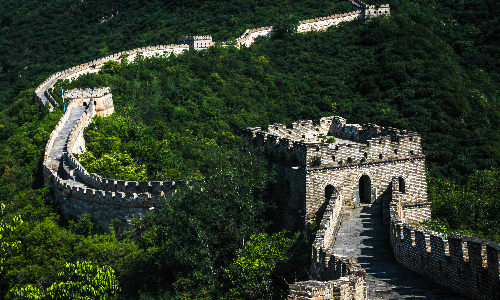

 Xi’an
Xi’an This morning you will take the estimated flight MU2160 10:55/13:15 to Xi’an. Your local guide will be waiting for you at the airport.
In the afternoon you will visit Xi’an Old City Wall, also known as Xi’an Ming City Wall, which is the largest and best-preserved ancient city wall in China. The city wall, located in the central area of the city, is 12 meters high, 12 to 14 meters wide at the top, and 15 to 18 meters wide at the bottom. The outline of the city wall is a closed rectangle, with a circumference of 13.74 kilometers. When you get to the top of the city wall, you will see people walking, running and riding bicycles on it. If it happens to be the Chinese New Year, you will have a chance to enjoy the beautiful lantern show on the city wall.


After having breakfast in the morning, you will visit Terra Cotta Warriors and Horses Museum. It is located in the northeast of Xi’an, 43 KM away from the city center (about 40 minutes’ drive). As one of the most important archaeological discoveries in the 20th century, the terra cotta warriors and horses are life-size sculptures used to guard Emperor Qinshihuang, the first emperor who unified ancient China for the first time. In 1987, Qinshihuang’s Mausoleum, together with the Terra Cotta Warriors and Horses, was listed on the world heritage list by UNESCO, known as the “eighth wonder of the world”. More than 200 foreign heads of state have visited the museum. When you have a close-up view of these sculptures, you will be amazed by their verisimilitude and grandness.
After lunch, you will visit the Small Wild Goose Pagoda (closed on Tuesday). It is located in Jianfu Temple, so it is also known as Jianfu Temple Pagoda. It is a Buddhist architectural heritage of the Tang Dynasty, built from 707 to 710 to store Buddhist scriptures. The pagoda originally had 15 stories. However, because of numerous storms and earthquakes, the upper two stories were destroyed and currently, 13 stories remain, with 43.4 meters in height.
After that, we will take you to Muslim Quarter, which is a famous food and culture block in Xi’an. Filled with various local foods, it is a paradise for foodies, where a large number of visitors linger around day and night. Local people are good at snack making with fresh ingredients and varied tastes, sweet, salty, and spicy. In this place, you will discover hundreds of snacks, such as mutton pie, steamed cold noodles, mutton or beef dumplings, and mutton shashlik. You must try these delicacies.
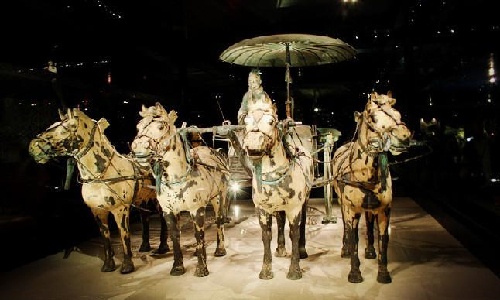

 Lhasa
Lhasa This morning, after breakfast at the hotel, you will be transferred to the airport and go to Lhasa by taking the estimated flight MU2147 09:35/13:10. After airport pick-up, you will be transferred to a local hotel.
Lhasa, also known as Sunshine City, is located in the southwest of China, the central part of the Tibetan Plateau, the northern side of the Himalayas. With an altitude of 3,650 meters, it enjoys a unique climate with sunny weather throughout the year and little rainfall. As the political, economic, cultural, educational, and scientific center of Tibet, it is a sacred place of Tibetan Buddhism as well. It is world-famous for its beautiful scenery, long history, unique customs, and strong religious flavor.
After having breakfast in the morning, we will go to visit the fabulous Potala Palace. As a palatial building complex of Tibetan style, the Potala Palace consists of two parts: the White Palace and the Red Palace. The whole palace featuring Tibetan elements combines Han, Indian and Nepalese Buddhist art techniques. Built on the Red Mountain, the whole building seems to be integrated with the mountain. The Potala Palace has a large collection of precious cultural relics, including exquisite murals, nearly a thousand Buddhist pagodas, tens of thousands of Buddha statues, numerous pieces of Thangka (Tibetan Buddhist painting), and Buddhist scriptures. As a sacred place of Tibetan Buddhism, the Potala Palace attracts countless pilgrims and tourists every year. You will be amazed by these exquisite artworks.
After lunch, you will arrive at the Jokhang Temple, which is located in the center of Lhasa. It is a Tibetan Buddhist temple built by Songtsen Gampo (617-650), the king of the Tubo Kingdom (633-842). It is the first temple built in Tibet, which was built to enshrine Buddha statues and Tibetan Buddhist scriptures. Combined with Tibetan, Tang, Indian and Nepalese architectural styles, the Jokhang Temple becomes an ancient model of Tibetan religious architecture. The Jokhang Temple holds the highest position in Tibetan Buddhism. It never belongs to any sect of Tibetan Buddhism. It is a sacred temple respected by all sects. Besides, the ordination ceremonies for the Dalai Lama and Panchen Lama are also held here.
Then you will reach Barkhor Street. Barkhor Street is the most famous circumambulation road and commercial center in Lhasa. It is in the center of Lhasa surrounding the Jokhang Temple. In the 7th century, Songtsen Gampo built the Jokhang Temple. This sacred Buddhist temple attracted countless pilgrims who came to visit it and gradually a path was worn on the ground by their feet. After over a thousand years of development, it has become what we see today. On the street, you can see some Tibetans performing sacred prayer ceremonies to express their inner piety to the Buddha. The Tibetan-style houses facing the street are almost shops, selling all kinds of Tibetan costumes and handicrafts as well as goods from India, Nepal, and other neighboring countries. There are also a lot of Tibetan restaurants where you can taste the most authentic Tibetan dishes.
After today’s visit, you will go back to the hotel and have a good rest.
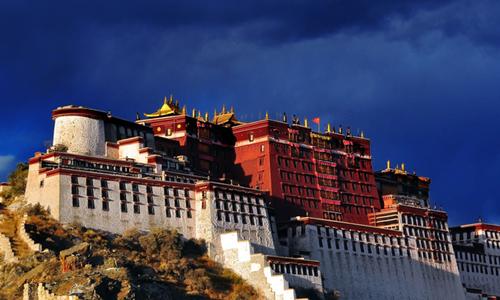
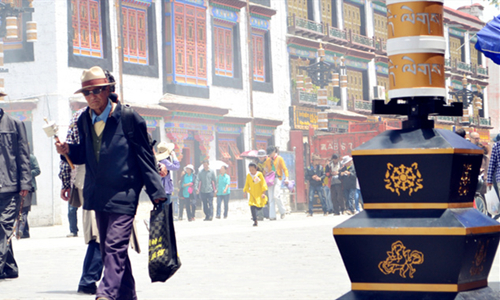
After having breakfast, we will take you to visit Norbulingka Park, which is a typical Tibetan-style garden and is the largest man-made garden in Tibet, with the best scenery and the most historical sites in Lhasa. Norbulingka Park was once the summer palace of the Dalai Lamas, where the Dalai Lamas used to spend their summers. Every summer, many government offices in the Potala Palace would move to Norbulingka Park with the Dalai Lama. Now it is a people’s park in Lhasa. There are two kinds of cultural relics in Norbulingka Park: the religious relics made locally in Tibet and a variety of treasures given by the central governments of all dynasties, hence the name Norbulingka, which means “Garden of Treasures” in Tibetan language. There are green lawns, pine trees, cypress trees, bamboo forests, and flowers of many kinds. The winding roads in the park will lead you to admire the amazing beauty and you will feel like entering a natural oxygen bar.
After enjoying lunch, we will take you to your next destination—Drepung Monastery. Located in the western suburbs of Lhasa, it was founded in 1416. As the largest monastery in Lhasa and even in Tibet, the amount of its precious relics in Drepung Monastery is staggering. The main building of the monastery is the Grand Sutra Hall, which has 183 columns and exquisite carvings. It is also decorated with exquisite weaving and embroidering sutras, scroll paintings, and frescoes. At the same time, it can accommodate 8,000 people to chant sutras. The monastery also preserves a large number of ancient Tibetan documents and scriptures. There is also a platform in the monastery for you to get a perfect view of the Potala Palace in the distance.
Then you will take a visit to the Sera Monastery. “Sera” in Tibetan language means roses. It is said that the monastery was built in a place where wild roses were in full bloom, hence the name “Sera Monastery”. Gandan Monastery, Drepung Monastery, and Sera Monastery are known as “The Three Major Monasteries in Lhasa”. Sera Monastery houses tens of thousands of Buddha statues. There are also many bronze Buddha statues brought from ancient India. The most famous one is a Buddha statue with a horse head. It is said that it is the incarnation of Bodhisattva of Compassion. You can take a closer look at this statue and find out why it is so famous.
Then you will be transferred to your hotel.

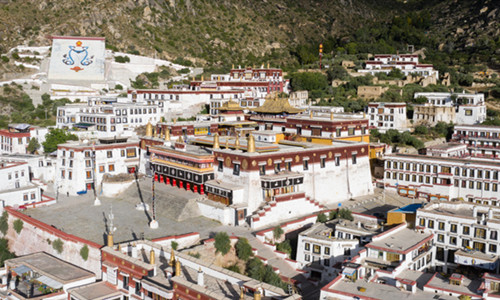
 Shanghai
Shanghai After breakfast, you will go to Shanghai by taking the estimated flight TV9881 09:25/15:30. Upon arrival, your guide will pick you up and take you to the hotel to have a good rest.
Option:
If you want to have a look at the city in the evening, you may take a Huangpu River Night Cruise. There are many different cruise ships for you to choose from. There are also different cruise routes, some lasting for about half an hour and some for about an hour. During the night cruise, you can enjoy the beautiful night view on the two banks of the Huangpu River. It’s really a great experience to know about this city.
Today, you will go to the famous Yu Garden (closed on Mondays) after having breakfast. It is a famous classical garden in the southern regions of the Yangtze River. Built in Ming Dynasty, Yu Garden has a history of more than 450 years. It is famous for its delicate beauty. Even though it’s not very big, it is divided into several scenic areas by means of different Chinese gardening techniques. Many leaders and celebrities from home and abroad have visited Yu Garden. In 2019, President Xi Jinping and his wife Peng Liyuan cordially met French President Macron and his wife in the Yu Garden and accompanied them to appreciate the beauty of this garden.
The next place comes to Shanghai Old Street. Shanghai Old Street used to be an important venue for Shanghai’s foreign trade. Shanghai Old Street brought together Shanghai’s earliest banks, gold and silver shops, teahouses, opera houses and so on. Now, it is a good place to experience old Shanghai. In the street, you can see the Chunfeng Deyi Building. It is the oldest teahouse in Shanghai, which was built in the late Qing Dynasty. You can have a cup of tea and know about the local tea culture.
We will then take you to the Xintiandi Area. It is an urban tourist attraction featuring Shanghai’s old Shikumen architecture and fashionable businesses. Do you know what a Shikumen building is? Shikumen literally means stone warehouse gate. It is a traditional Shanghai-style folk house. A Shikumen house is a two or three-story building with high brick walls enclosing a narrow front gateway. The entrance of the gateway is usually built with a stylistic stone arch on the top. When you walk around this area, you will feel like you were going back to old Shanghai. However, when you step into one Shikumen building, you will be extremely surprised because most of them are western restaurants, bars, cafes, and fashion shops with modern decorations. It’s really worth a visit.
After enjoying lunch, you will head for the Former French Concession. Among the four French concessions in modern China, Shanghai’s Former French Concession is the earliest, largest and most prosperous one, exceeding the other three French concessions in Tianjin, Hankou, and Guangzhou respectively. The buildings here are exceptionally beautiful. They are all old European-style buildings. There are also many century-old oriental plane trees along the streets here. The exotic old buildings shaded by the green tall oriental plane trees are much more attractive. There are also a lot of stylish coffee shops. If you are tired, you can step into one and have a cup of coffee, enjoying this afternoon leisurely.
Then you will arrive at the Bund. Located on the bank of Huangpu River, the Bund is a Chinese historical and cultural block that is telling the story of old Shanghai. In 1844, the Bund was designated as the British Concession and gradually developed into the financial center of the Far East (all countries of Eastern Asia). The Bund is 1.5 kilometers long and there are 52 classical revival buildings in different styles on the Bund, which is known as the “Exhibition of International Architecture on the Bund”. You can stroll along the Bund to appreciate these buildings one by one.
The next place to be visited is Nanjing Road. Nanjing Road is a world-famous commercial street. From the Bund in the east to Yan’an West Road in the west, the road has a total length of 5.5 kilometers. On both sides of the road are commercial buildings, gathering about more than 700 shops. It is the earliest commercial street established after Shanghai opened its commercial port. It used to be the most prosperous commercial street in the Asia-Pacific region before 1949. It is a place that has witnessed the significant changes happening in Shanghai. Strolling along Nanjing Road, you can not only appreciate its century-old buildings but also enjoy the pleasure of shopping in this shopping paradise.
After that, our guide will take you back to your hotel to have a good rest.


Today you will go to Zhujiajiao Water Town after enjoying your breakfast. We will drive southwest from Shanghai downtown for about 50 minutes (about 50 kilometers) to get there. It is a typical ancient water town in the south of the Yangtze River. In the water town, nine long old streets stretch along the river; over a thousand Ming and Qing buildings stand along the streets; 36 stone bridges still remain the ancient style. The slow-paced life in this ancient town is also enviable. The landmark of Zhujiajiao Water Town is the Fangsheng Bridge, which connects the north and south parts of the water town. First built in the Ming Dynasty and rebuilt in the Qing Dynasty, it is the longest and largest five-arch stone bridge in Shanghai. At sunrise in the early morning and sunset in the late afternoon, it is the best place to enjoy the scenery on both sides of the water town. As it is a water town, you will board a wooden boat, winding through the waterway to appreciate the scenery on both sides.
Lunch will be served in this ancient water town, and then you will be taken back to the city center to visit the Shanghai Tower. It is the tallest building in Asia and is second only to the Burj Khalifa in Dubai, the tallest building in the world. With a total investment of 15 billion yuan (2.3 billion US dollars), it is a super high-rise building with multiple functions including business office, hotel, entertainment, and sightseeing. The Shanghai Tower has a height of 632 meters (2,073 feet) with 127 floors above the ground. Its appearance is spiraling upward, symbolizing continuous prosperity and development of Shanghai. The 118th-floor Top of Shanghai Observatory, surrounded by large transparent glass curtain walls, will give you a 360-degree panoramic view of Shanghai. You can have a vertical view of the Oriental Pearl TV Tower, Jinmao Tower and Shanghai World Financial Center from top to bottom, and a panoramic view of the Bund. What’s more, you will witness the Huangpu River winding its way to the Yangtze River and finally to the East China Sea. This visit will surely be a perfect end to your journey to Shanghai. Then we will take you back to the hotel so as you can have a nice rest.
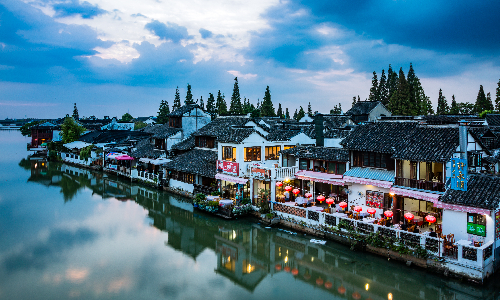
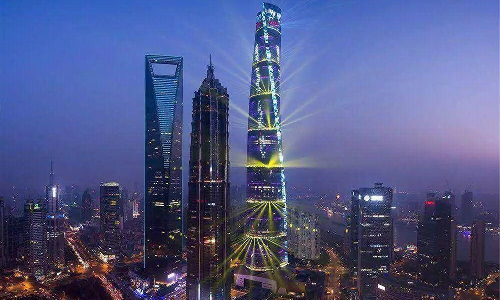
 Suzhou
Suzhou Shanghai
Shanghai This morning, we will head for Suzhou after breakfast. Suzhou is about 100 kilometers away from Shanghai. We will drive westward for about one and a half hours. The first stop you will arrive at is Tiger Hill. It is located in the northwest corner of the ancient city of Suzhou. With a long history of more than 2,500 years, it enjoys the reputation of the No.1 attraction and the No.1 hill in Suzhou. Tiger Hill was originally called Haiyong Hill. According to historical records, He Lu, the king of Wu State during the late Spring and Autumn Period (770 BC-476 BC), was buried here. Legend has it that there was a white tiger squatting on the hill three days after the burial, hence the name Tiger Hill. The most mysterious place here is the Sword Pool, which is said to be the entrance of He Lu’s tomb.
Then you will take the Canal Boat from Tiger Hill. Taking a cruise along the ancient canal is the best way to witness the local life of Suzhou people. During the cruise, you can see the antique and bustling lanes while feeling the strong vitality of folklife. Sailing through the ancient canal, passing under many old bridges, looking at the green willows, and watching the ripples of the water are all included in this cruise tour.
After the cruise tour, you will come to Shantang Street. Shantang Street was first built in the Tang Dynasty. It has been known as “the first street in Suzhou”. It is said that it was built by Bai Juyi, a great poet of the Tang Dynasty. At that time, Bai Juyi served as the governor of Suzhou. He dredged the northwest river channel of Suzhou and widened it into the Shantang River. The ancient street built next to the Shantang River has been called Shantang Street. There are many ancient buildings on both sides of the street. Most of them were built in the late Qing Dynasty. Shantang Street can be divided into two sections. The east section is a bustling commercial area, crowded with tourists and shops. The west section is close to the outskirts, presenting idyllic scenery. You will be amazed by the surrounding landscapes of Shantang Street.
The last stop in Suzhou is the Humble Administrator’s Garden. It was founded in the first half of the 16th century with a history of over 400 years. With an area of 5.2 hectares, it is the largest classical garden in Suzhou. The garden is an outstanding representative of Chinese classic gardens and a model of private gardens in south China. Along with the Summer Palace in Beijing, the Mountain Resort in Chengde, the Lingering Garden in Suzhou, the Humble Administrator’s Garden has been known as one of the “four famous gardens in China”. It is well known for its long cultural history, superb achievements in garden construction, elegant and beautiful scenery. The whole garden is centered on water, decorated with artificial hills, scattered with exquisite halls and pavilions, and planted with luxuriant flowers and trees, embodying strong characteristics of classic south-China-style gardens. You will be deeply impressed by its unique charm.
After visiting, we will drive back to Shanghai.
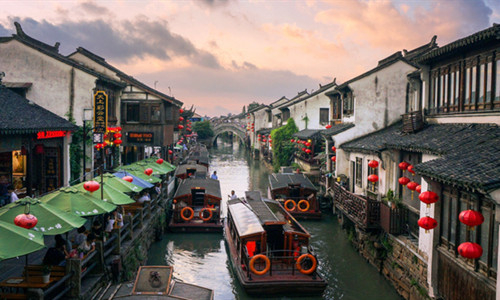

Today is the last day of your wonderful China adventure tour with Tibet. Our guide and driver will pick you up at the hotel and transfer you to the airport according to your flight schedule. We sincerely hope you have had a great time on this trip and wish you a pleasant homebound journey.
Our service ends here.
Editor: Jiao Chen
Proofreader: Vivian Zhou
| City | Five Star hotel list | Four Star hotel list |
|---|---|---|
| Beijing | Sunworld Dynasty Hotel Beijing Wangfujing | Jianguo Qianmen Hotel |
| Xi'an | Tianyu Gloria Grand Hotel Xi'an | Xian Grand Dynasty Culture Hotel |
| Lhasa | Shangri-La Hotel, Lhasa | Thangka Hotel |
| Shanghai | Ocean Hotel Shanghai | Ambassador Hotel |
 |
![]() About your child or infant, please contact us for a discounted price.
About your child or infant, please contact us for a discounted price.



We started with a few days in Beijing & ended in Shanghai, from where we visited the Forbidden City and Great Wall. In between we visited Terra Cotta Warriors Museum, Panda Base, Shanghai Disneyland.

We had a wonderful holiday in China which will remain long in the memory. China is a breathtakingly beautiful country full of splendid temples and palaces, mountains and rivers, peaceful rural scenes and bustling shopping streets.
 QUICK ENQUIRY
QUICK ENQUIRY